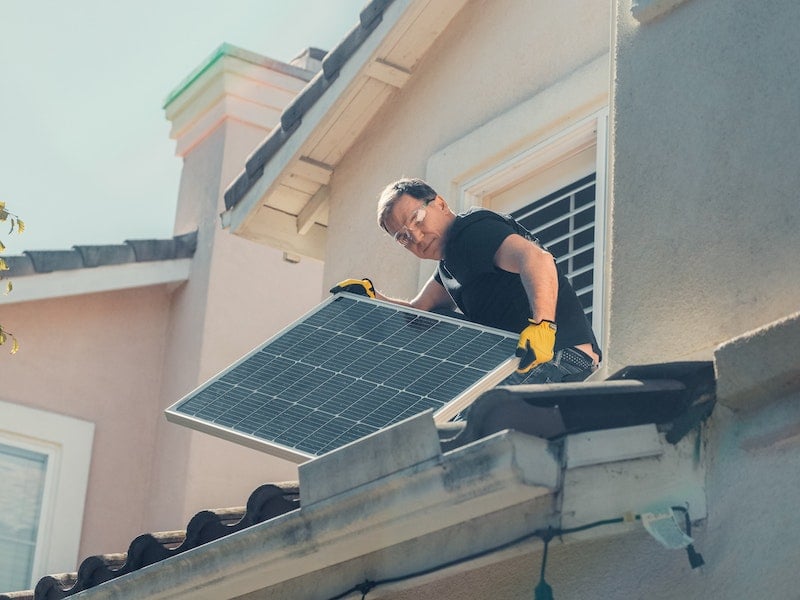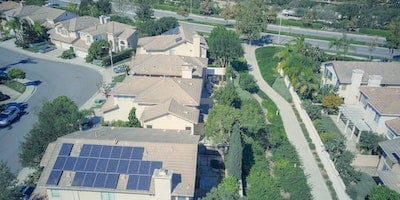
How Efficient Are Solar Panels
How efficient are solar panels compared to other types of energy generation?
Is solar right for you?
Find out in less than a minute.
How Efficient Are Solar Panels
Solar panels have an efficiency between 15 to 20%. That sounds terrible!
This average begs so many more questions. How is this efficiency determined? What affects solar efficiency?
How is Solar Efficiency Measured?
Let us start with how solar efficiency is measured. The efficiency is displayed as a percentage and comes from the following equation:

You may have already learned about efficiency from our How to Calculate Energy Efficiency post. Efficiency is typically determined from a ratio of energy in and energy out. However, solar power efficiency is a ratio of its power out and panel area.
In our case, sunlight is the energy coming in. We are looking to compare the energy of the sun coming in, to the energy output of the panel. If the panel converted all of the sunlight coming in it would be 100% efficient. However, reaching 100% is impossible today.
Why is sunlight energy not present? Well, it is.
The sunlight energy coming in is in the form of area instead of energy. The amount of sun we receive may change between locations or cloudiness. However, the sun’s energy it emits never changes. We are instead changing the amount of energy we are able to capture by how much area we can cover.
Imagine the solar panels as a net catching the sun's rays. What we are trying to determine is how many rays can each net catch. If we have a small net that catches more rays, it is more efficient than a big net catching fewer rays.
In terms of panels, a 100W panel that is 1m2 is 10% efficient. A 100W panel that is 0.5m2 is 20% efficient. A panel that is half the area has double the efficiency.
It is also important to note that solar panel manufacturers have to follow Standard Test Conditions (STC). Since the amount of solar energy at noon at the equator is the maximum, it is the baseline for efficiency ratings.
Will technology advancements ever get us to higher solar efficiencies?
Today, the theoretical maximum efficiency is 33.7%. It is known as the Shockley-Quiesser limit. Due to the laws of physics and other limitations of today, 33.7% is seen as the ceiling for solar panel production.
Under lab conditions, scientists can surpass this limit. Manufacturing challenges and cost of solar limitations make the lab creations only available to select applications like satellites.
Scientists are advancing technology in solar production all the time. It's likely to see solar efficiency continue to increase.
What affects solar efficiency?
Material
There are 3 main types of solar panels:
- Monocrystalline Solar Panels
- Polycrystalline Solar Panels
- Thin Film Solar Panels
Monocrystalline: Monocrystalline solar cells are made from a single layer of pure silicone. They are the highest costing but most efficient type of photovoltaic cell. These panels are dark black.
Polycrystalline: Polycrystalline panels are made from different types of silicone. Silicone fragments are melted and poured into square molds. They are more affordable but less efficient.
Thin Film: Thin Film panels are made similarly to Polycrystalline. The difference is, they are layered so thinly that they are flexible. This makes them even less efficient.
Integration
How the solar panels are integrated into the system and building could affect the overall efficiency. Inverters, the electrical panel, and the wiring are important to the overall performance. Your solar installer will work along with you and your electrician to find the best configuration for your wallet and efficiency.
Environment
Without intending to be too overt, the more sun a panel receives, the more efficient it will be. This makes the panel's location and environment are critical to its performance.
The equator at noon receives the most possible sun energy. The further away from the equator you travel, the less sun energy you can capture. The sun is no longer directly above.
But you probably aren't looking to move.
You can, however, change the tilt of the panels. Optimize your panel's performance by angling them perpendicular to the sun's rays. If you are located in the United States, North of the equator, facing the panels South is the most efficient.
Alternatively, solar panels located south of the equator must face North.
Panels facing East or West can still perform well. Yet they wouldn't be generating at their highest efficiency.
Finally, weather. In short, anything blocking sunlight will hinder solar energy generation. You can expect a noticeable difference in performance from clouds, dust, leaves, snow, and kids kicking balls onto your roof. It is critical to keep your system clean.
You may have heard that one leaf can drastically reduce performance. In fact, shading 1/36 of the cells can reduce power output by 75%. While that is true, there are technological improvements in wiring, module add-ons, and inverters to reduce the shading effect.
If you are located in a colder climate, you may be reluctant to get a solar system because
A Solar Installer or Energy Engineer help you find the best solution with solar software. The software determines the sun's angle by location, typical weather conditions, panel tilt and height, neighboring shading from trees and buildings, integration equipment, cost, and other variables.
If you are looking for more information about installing solar panels, check out further resources below:
Written by Hannah Bastawrose (Seeger)
Hannah graduated from Penn State with a Bachelors Degree in Mechanical Engineering and a Minor in Meteorology.
Connect
Recent Posts
Compare Texas Solar Buyback Plans
Discover the best Texas solar buyback plans for 2024! Compare rates, terms, and providers to maximize savings and make the most of your solar investment.
March 2024

7 minutes

How Efficient Are Solar Panels
How efficient are solar panels compared to other types of energy generation?
March 2023

4 minutes

What You Need To Know About The California Solar Mandate
Learn how the California Solar Mandate changes how new homes are built.
July 2023

4 minutes




